Design Notes and Legal Notes on URW Palladio
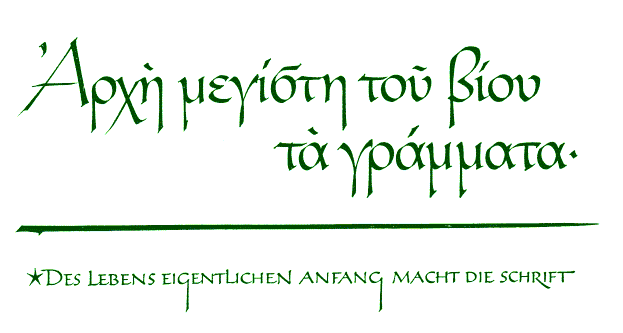
(Hermann Zapf's handwriting)
Fonts
for Classical and Vedic Sanskrit and other languages of India
TrueType,
PostScript Type 1, Unicode and OpenType Fonts
.
Searchable Files of transliterated Sanskrit texts are stored in a variety of encoding formats. For viewing and printing all these electronic textfiles downloadable from various websites you may download the following fonts from this site:
- "URW Palladio CSX+"
or "URW Palladio REEG" for
GRETIL
files,
- "URW Palladio
CSX+" or "URW Palladio KRN" for
Mahabharata
files,
- "URW Palladio
GGM" for Gaudiya-Grantha-Mandira
Sanskrit files,
- "URW Palladio
S" for searchable PDF files from our Sanskrit Web,
- "URW Palladio
KRN" for Pali textfiles from several Buddhism sites.
1. The fonts "URW Palladio GGM", "URW Palladio S", "URW Palladio SKT", "URW Palladio IT" and "SANSKRIT 99", based on Code Page 1252, are fully compliant with the original Adobe (PostScript Type 1) and Microsoft (TrueType) font specifications and are supported by all word processors, printer and pdf drivers, whether old (e.g. Word 6.0, 1993) or new (e.g. Word XP, 2002). These fonts are available in both PS Type 1 and TT format and can be recommended to everyone.
2. The fonts "URW Palladio CSX+", "URW Palladio KRN", "URW Palladio IS" and "URW Palladio REEG" are not compliant with original Adobe PostScript Type 1 specifications. Therefore these fonts are available only in TrueType format. These TT fonts work with old (e.g. Word 6.0, 1993) and new (e.g. Word XP, 2002) word processors, but they are recommended only for viewing and printing Sanskrit texts available in these encodings. Much research was necessary to make these old encodings compatible with the latest versions of Windows word processors.
3. The fonts "URW Palladio HOT", "URW Palladio ITU" and "Sanskrit 2003" can be used only with Unicode-savvy word processors. Whereas "URW Palladio ITU" is a plain Unicode font, "URW Palladio HOT" is a Unicode OpenType font. Plain programs (e.g. Word XP) cannot handle Latin OpenType fonts. Thus "URW Palladio HOT" can be recommended only to users of advanced programs (e.g. Adobe InDesign). However you can also use the two-in-one font "URW Palladio HOT" with Word XP etc. as a plain Unicode font, i.e. without using its OpenType features. The OpenType font "Sanskrit 2003" requires Windows XP (or Windows 2000) in connection with Word XP (or OpenOffice 1.1 Writer).
4. Macintosh: All fonts from this site are designed for Windows only. For Macintosh diacritics fonts for Sanskrit and Pali, please visit the sites of Prof. Dr. Gudrun Buehnemann (Sanskrit) and Phil Thompson (Pali). See the links below. There are two exceptions: The font "URW Palladio HOT" works on Macintosh, provided that the new OS X (10.2 or 10.3) is installed. And for Itranslator 99, special OTF fonts for Mac OS X users as well as "classic" PostScript fonts for all Mac users were made, see here.
5. Für Deutschesind nur (a) die vier 8-Bit-Schriften "URW Palladio SKT", "URW Palladio S", "URW Palladio US" und "URW Palladio IS", (b) die zwei 16-Bit-Schriften "URW Palladio HOT" und "URW Palladio ITU" zu empfehlen, weil nur bei diesen Schriftarten die deutschen Umlaute und das Eszett über die deutsche PC-Tastatur in der üblichen Weise eingegeben werden können.
6. For Indologists in Poland the fonts "URW Palladio SKT" and "URW Palladio KUL" complemented by "URW Palladio M" are recommended. These fonts were made for the "German-Polish Friendship Fonts" project and contain all 18 Polish diacritics, besides the diacritics required for Sanskrit, Pali etc.
Additionally a general-purpose German-Polish font "URW Palladio FF" was made including German and Polish diacritics arranged for both German and Polish keyboards (for keyboard layout see paff.gif or paffps.pdf). It also includes the Euro sign. To comply with Adobe Standard Encoding, one of the 18 Polish diacritics, capital Z acute, had to be relocated from keyboard position # 143 to # 190. All other Polish diacritics are accessible as usual. This font is designed for all those who need BOTH German AND Polish diacritics in ONE non-Unicode font, but who do not need diacritics for ancient oriental languages. It can be used for translating from German to Polish and vice versa and for all documents containing Polish and German texts. It comes in 4 styles: Roman, Italic, Bold, Bold Italic. The TrueType font is downloadable as paff.zip, the PostScript Type 1 font is downloadable as paffps.zip.
Design Notes and Legal Notes on URW Palladio

(Hermann Zapf's handwriting)
The font company
URW++
Design & Development GmbH, Hamburg, and the late world-famous typographer
Professor Hermann Zapf (1918-2015), Darmstadt, generously donated Prof. Zapf's font
URW Palladio to Ulrich Stiehl, Heidelberg, granting him permission to modify
and to add diacritical characters not contained in Prof. Zapf's URW Palladio
and to offer specialized URW Palladio diacritics fonts to Indologists,
Buddhologists etc. free of charge. All diacritics fonts at this website
using the Latin script are based on URW Palladio.
Letter by Hermann Zapf 2002
 The
prolific master-designer Prof. Hermann Zapf (see photograph), born in 1918,
made many typefaces for URW in Hamburg (URW Antiqua, URW Classico, URW
Grotesk, URW Latino, URW Palladio) and is best known for Palatino, Optima,
Melior, Zapf Dingbats, ITC Zapf Chancery and Zapfino. From 1990 dates URW
Palladio. Prof. Zapf lives in Darmstadt, Germany. He designed typefaces
for all typesetting machines of the 20th century: hot-metal typesetters,
photo-composition machines, CRT-typesetters and modern laser-imagesetters.
Palladio is based on the Palatino typeface, designed in 1950 for the former
D.Stempel AG and named after the calligrapher Giovanbattista Palatino,
a contemporary of Michelangelo. The Original Palatino of 1950, designed
as foundry type for handsetting, has been repeatedly adjusted to all subsequent
typesetting methods (photo-composition etc.). This explains that the modern
versions URW Palladio (1999) and Palatino Linotype (1998) differ considerably
from the Palatino of 1950, as is shown by this comparison (also downloadable
as pala.pdf for better viewing of serifs etc.):
The
prolific master-designer Prof. Hermann Zapf (see photograph), born in 1918,
made many typefaces for URW in Hamburg (URW Antiqua, URW Classico, URW
Grotesk, URW Latino, URW Palladio) and is best known for Palatino, Optima,
Melior, Zapf Dingbats, ITC Zapf Chancery and Zapfino. From 1990 dates URW
Palladio. Prof. Zapf lives in Darmstadt, Germany. He designed typefaces
for all typesetting machines of the 20th century: hot-metal typesetters,
photo-composition machines, CRT-typesetters and modern laser-imagesetters.
Palladio is based on the Palatino typeface, designed in 1950 for the former
D.Stempel AG and named after the calligrapher Giovanbattista Palatino,
a contemporary of Michelangelo. The Original Palatino of 1950, designed
as foundry type for handsetting, has been repeatedly adjusted to all subsequent
typesetting methods (photo-composition etc.). This explains that the modern
versions URW Palladio (1999) and Palatino Linotype (1998) differ considerably
from the Palatino of 1950, as is shown by this comparison (also downloadable
as pala.pdf for better viewing of serifs etc.):
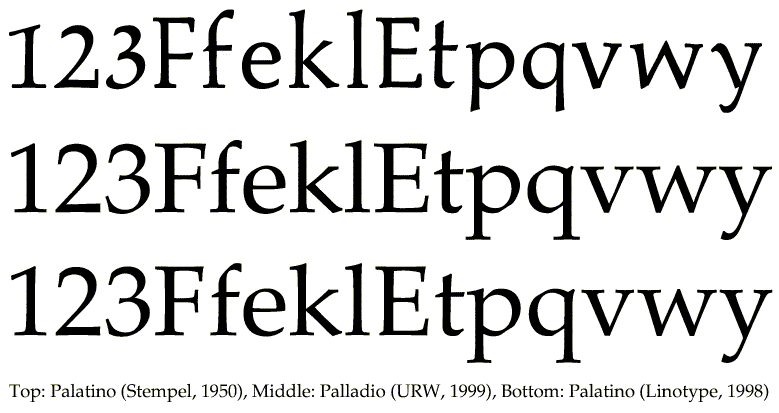
The Original Palatino of 1950 is characterized by taller ascenders (b, d, f, h, k, l) and much lower figures, by a much more moderate contrast between upstrokes (hairstrokes) and downstrokes (mainstrokes), and by a lot of artistic peculiarities in the formation of strokes and serifs. Have a closer look at the downstroke of y, the roof serifs of v and w, the cross bars of E and F, the tiny counter of e, the unserifed beveled downstrokes of p and q, etc. etc.
The design of Prof. Hermann Zapf's Palladio has been used in the specialized diacritics fonts described below. But a great number of letters were provided with diacritical marks necessary for transliterating Indic scripts, and several completely new characters had to be added to these diacritics fonts. All these specialized Palladio diacritics fonts are available free of charge and may be used by anyone. However, who wants to modify the URW Palladio font, must apply to URW++ Design & Development GmbH and to Prof. Hermann Zapf for written permission. And who wants to modify the special diacritics fonts offered at this website must apply to Ulrich Stiehl for written permission. This notice would be unnecessary, if every scholar would respect this. However, this is not always the case. For instance, have a closer look at the so-called "Nina" font used by the "International Journal of Tantric Studies":
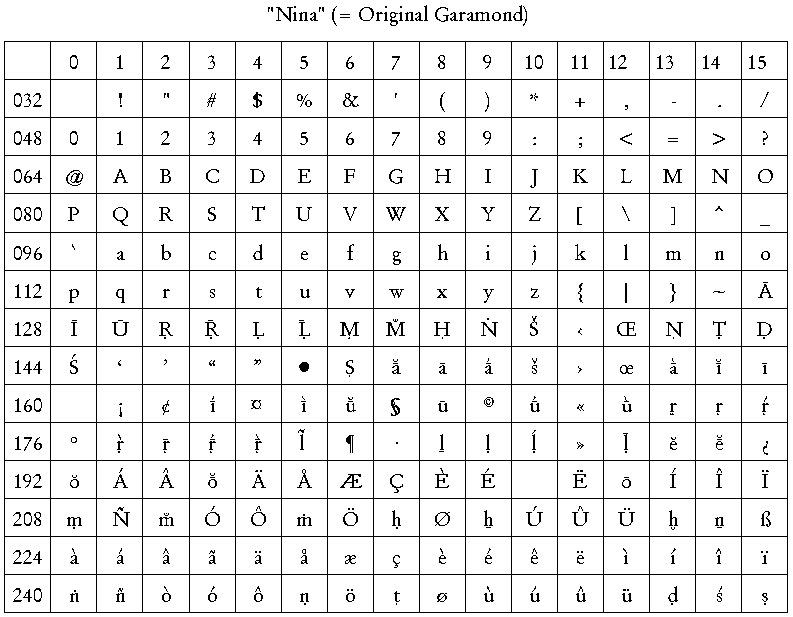
It is easily recognizable that "Nina" is identical with "Original Garamond", designed by D. Stempel AG in 1926 on the basis of a typecut attributed to the Renaissance typecutter Claude Garamond. In 1996, the trademark "Original Garamond" was replaced by the fancy name "Nina", and the "International Journal of Tantric Studies" (IJTS), edited by Prof. Michael Witzel (Harvard University), claimed that the IJTS holds the "copyright" in the "Nina" font. Is this the usual method, by which "original" works are created at Harvard? It is assumed that academics are mentally able to understand that the trademark "Original Garamond" should not have been replaced by the fancy name "Nina" and that the original notice should not have been replaced by the notice "Copyright (c) 1996 International Journal of Tantric Studies. All rights reserved."
This Hybrid ("two in one" and backwards compatible) OpenType font can be used in two different ways:
- as a full-featured
OpenType
font by users of an OpenType-savvy word
processor (e.g. Adobe InDesign)
- as an ordinary
Unicode
font by users of a non-OpenType-savvy
word processor (e.g. Microsoft Word)
The new version 2.0 of this flagship font, available as of 10th March 2004, covers the following diacritics:
1. All characters of the four Windows Code Pages for Pan-European Latin alphabets, i.e. 1252 (Western Europe), 1250 (Central and Eastern Europe), 1257 (Baltic), 1254 (Turkish), and also all characters of six Macintosh Code Pages (US Roman, Central Europe, Croatian, Icelandic, Romanian and Turkish).
2. All diacritics required for ISO 15919 ("Transliteration of Devanagari and related Indic scripts into Latin characters": Vedic, Sanskrit, Hindi, Marathi, Bengali, Gujarati, Kannada, Telugu, Tamil, etc. etc. etc. - see Dr. Anthony Stone's ISO 15919 website) and many other non-ISO 15919 diacritics used in Indology, e.g. the additional diacritics used in the Sanskrit TITUS files, e.g. the additional diacritics needed by Buddhologists (Pali, Tibetan, Chinese, etc.), e.g. additional metrics symbols etc. etc. etc.
3. All 570+ characters are available in 5 styles: Roman, Italic, Bold, Bold Italic, and also Small Capitals for professional typesetting.
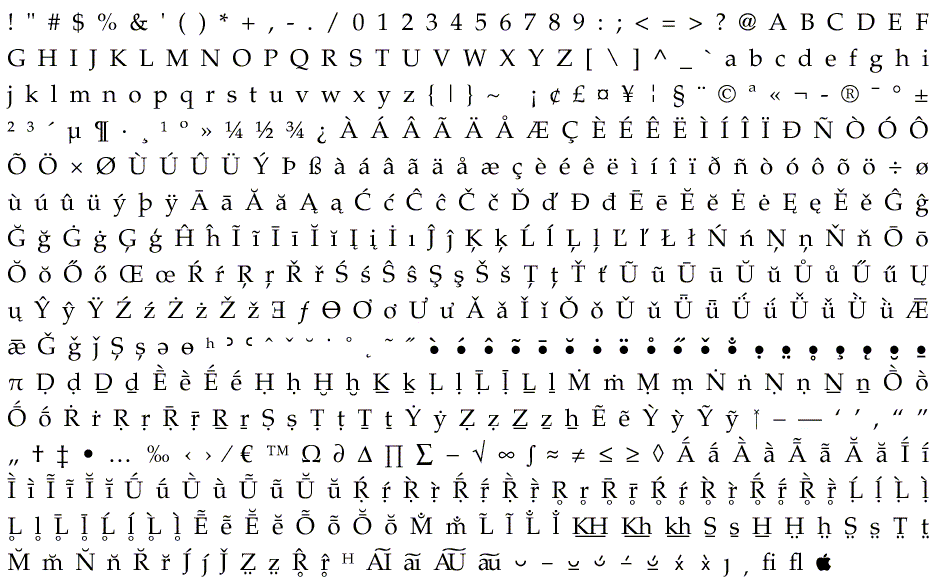
Note: The font URW Palladio HOT to which I have devoted so many months of hard work is not available to the public and must not be offered for download on the internet. It is only available to my friends. I will not reply to font requests by other persons.
- The font URW Palladio
HOT 2.0 (all 5 styles) is available to my friends via email as PaHOT20.zip
(530 KB).
- The detailed 51-page
"Technical Manual of URW Palladio HOT" is downloadable as PaHOTman.pdf
(878 KB).
In 1990, an encoding for Classical Sanskrit (CS) and Classical Sanskrit Extended (CSX) was devised by John Smith, Dominik Wujastyk and other Indologists. In 1998, this encoding was modified to Classical Sanskrit Extended Plus (CSX+). The CSX+ encoding is widely used by Indologists, e.g. for the electronic files of the BORI edition of the Mahabharata.
As the CSX+ encoding is based on Code Page 437, the old fonts from the Sites of John Smith and Dominik Wujastyk (see links below) are compatible only with old Windows 3.1 + old Winword 6.0. These fonts are incompatible with all later versions of Windows: Several diacritics "vanish", when these fonts are used under Windows 1995, 1998, ME, NT, or XP.
Therefore a new TrueType font with the old CSX+ encoding was designed. This new font takes care of the different internal handling by the newer versions of Windows (never disclosed by Microsoft) concerning the reserved (= undefined) slots #128, #129, #141, #142, #143, #144, #149, #157, #158, #183, which are highly critical. Furthermore, a few reserved slots of the 1252 code page have been defined in recent years, e.g. for the Euro sign and for the diacritics Zcaron and zcaron. But there are still a few reserved slots that can be used for additional diacritical characters. How to use these reserved 1252 code page slots in TrueType fonts is explained in the technical manual Howto.pdf (5 pages, 130 KB).
The new font URW Palladio CSX+ comprises the complete CSX+ character set with old encoding:
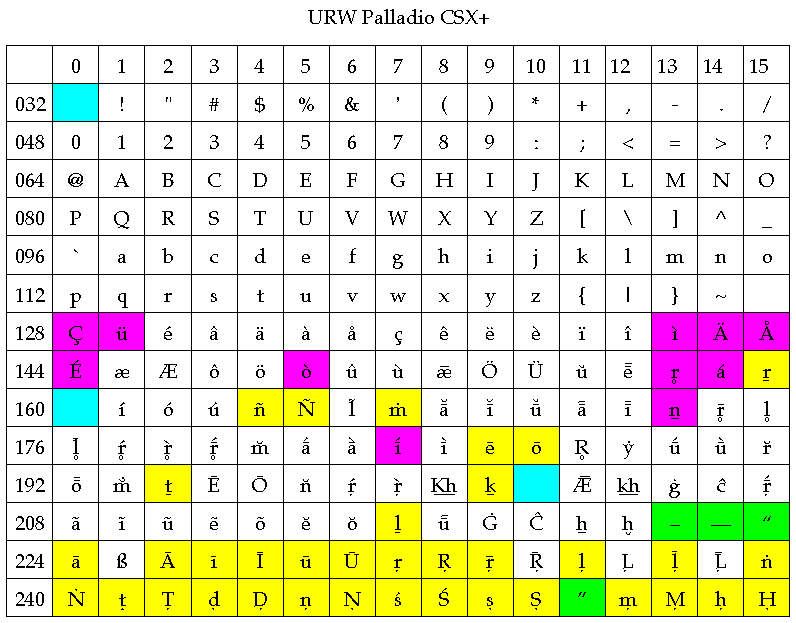
Yellow: Diacritics
used by GRETIL
Magenta: Critical
character slots
Green: Relocated
Printer's Specials
Cyan: Spaces (#202
= Macintosh)
URW Palladio CSX+ comes in 4 styles (Roman, Italic, Bold and Bold Italic), as shown in PaCSXp.pdf.
URW Palladio CSX+ using all reserved slots (with the exception of slots #127 and #160) has been sucessfully tested with many Word/Windows combinations: Windows 3.11 + Word 6.0, Windows 1995 + Word 1997, Windows 98 + Word 6.0, Windows 1998 + Word 1997, Windows ME + Word 1997, Windows 2000 (NT) + Word 2000, Windows XP + Word XP. The URW Palladio CSX+ font even works with the old program "Write for Windows" (1993) and Windows 3.1 (1993).
Since this old CSX+ font, which was uploaded by me in November 2002, is still used by various scholars, I have improved the screen display (= the font hinting) and uploaded new versions in August 2005. The new TTF font - plus a Word document for testing purposes - is downloadable as PaCSXp.zip. The new OTF font suitable for Windows XP users is downloadable as PaCSXpOT.zip. Please note: Either use the TTF version or the OTF version, but do not install both versions at the same time.
The site of John Smith (see links below) offers another old font, the encoding of which was drafted by Prof. Kenneth Roy Norman almost two decades ago. This "Norman Font", a variant of which was made by the University of Leeds under the name "LeedsBit Pali Translit", has the same drawback as the old CSX+ font, in that it is compatible only with old Windows 3.1 + old Winword 6.0, as this font uses the critical characters slots.
For researchers at the Universities of Oxford and Leeds, who still use Norman/LeedsBit encoding (e.g. the 144-page public domain book "An Elementary Pali Course" by Narada Thera is available as LeedsBit encoded Word textfile), the new font URW Palladio KRN has been designed, which is compatible with modern versions of Windows (1998/2000/XP).
The new font URW Palladio KRN comprises the complete Norman/LeedsBit character set:
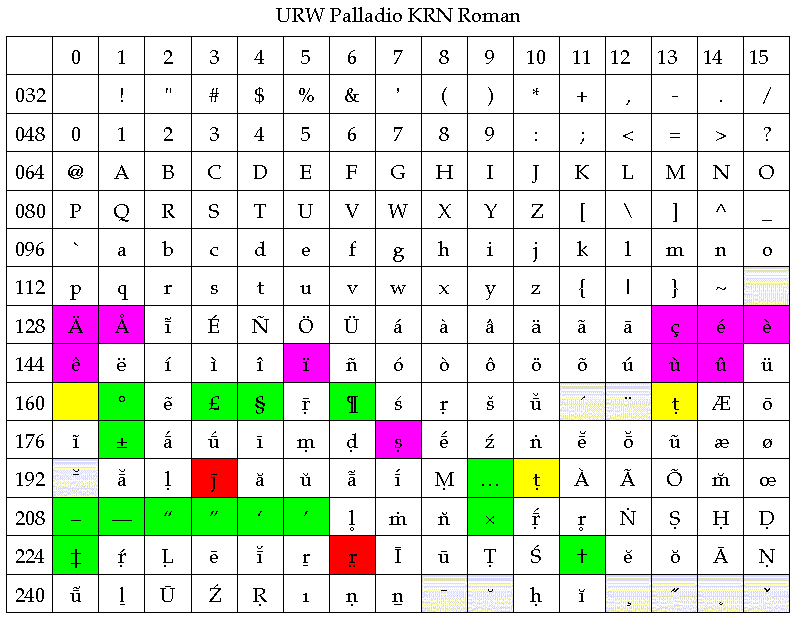
The above chart is also downloadabe as PaKRN.pdf for printout and better viewing of the diacritics:
Magenta: Critical
character slots
Yellow: "t underdot"
(see below)
Green: Relocated
Printer's Specials
Gray: Spacing accents
Red: Two special
diacritics
White: All other
diacritics.
Note on "t underdot": In the original Norman font, the diacritic "t underdot" was located at slot #160 (nobreak space), which is unusable in modern Windows. If you type Alt 0160, Windows will insert #32 (space), so that you have never a chance to enter a diacritic located at slot #160. In the modified version of the Norman font, J.Smith moved "t underdot" to slot #173, and in the LeedsBit font, "t underdot" was moved to slot # 202. For this reason URW Palladio KRN has TWO "t underdot" characters, so that you can use ONE font for both "Norman" and "LeedsBit" encoded texts.
The TrueType font URW Palladio KRN comes in one style only - Roman - and is downloadable as PaKRN.zip.
This font is designed for the IndoSkript Project of the Universities of Berlin and Halle (IndoSkript).
The keyboard layout of Palladio IS, viewable in high quality as PaIS.pdf, is shown on following chart:
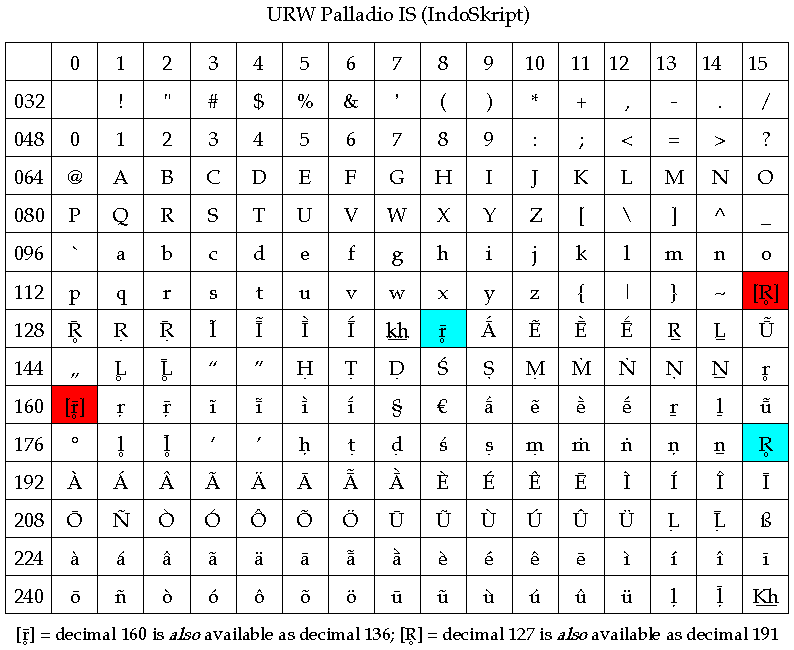
This TrueType font URW Palladio IS comes in 4 styles - Roman, Italic, Bold, Bold Italic - and is available as PaIS.zip.
Note: The font was made by me at the request of Prof. Harry Falk for the new 2003 IndoSkript CD and is contained on it. You need not request this font from me, if you order the new CD from the Universities of Berlin or Halle.
This font featuring a SUBSET of the REE encoding (named in honor of the late Prof. Ronald E. Emmerick) is used in GRETIL archive files by the University of Goettingen for Sanskrit documents and comes in one style - Roman - only.
The keyboard layout of Palladio REEG, viewable in high quality as PaREEGps.pdf, is shown on the following chart:
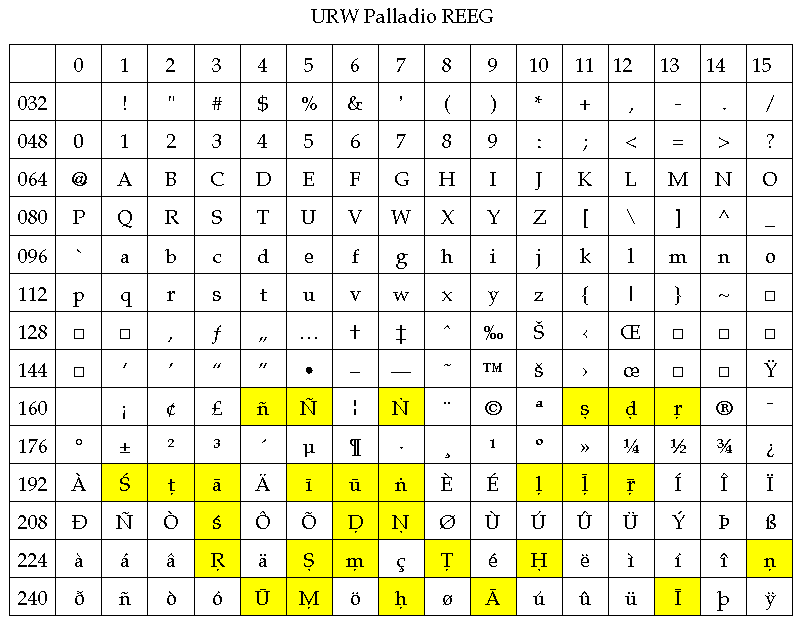
The TrueType font is downloadable as PaREEG.zip, the PostScript Type 1 font is downloadable as PaREEGps.zip.
This font Palladio GGM with Balaram encoding has been designed for the Sanskrit documents of the Gaudiya Grantha Mandira website featuring (a) classical Sanskrit texts and (b) a variety of other Sanskrit texts from medieval Bengal.
URW Palladio GGM comes in 4 styles - Roman, Italic, Bold and Bold Italic.
The keyboard layout of Palladio GGM, viewable in high quality as PaGGMps.pdf, is shown on the following chart:

The TrueType font is downloadable as PaGGM.zip, the PostScript Type 1 font is downloadable as PaGGMps.zip.
Since September 2004, a special OpenType version "URW Palladio GGMo" is downloadable as PaGGMotf.zip.
This font has been specifically designed for creating very compact searchable PDF files of Sanskrit texts. The font is restricted to the 15 essential Sanskrit lowercase diacritics and a few uppercase diacritics to speed up and ease searching of PDF files and has a size of 30 KB only as PostScript Type 1 font, although it is manually hinted for high-quality screen legibility even in smallest point sizes.
URW Palladio S comes in 1 style - Roman. Usage of 4 styles would increase the size of PDF files.
The keyboard layout of Palladio S, viewable in high quality as PaSx.pdf, is shown on following chart:
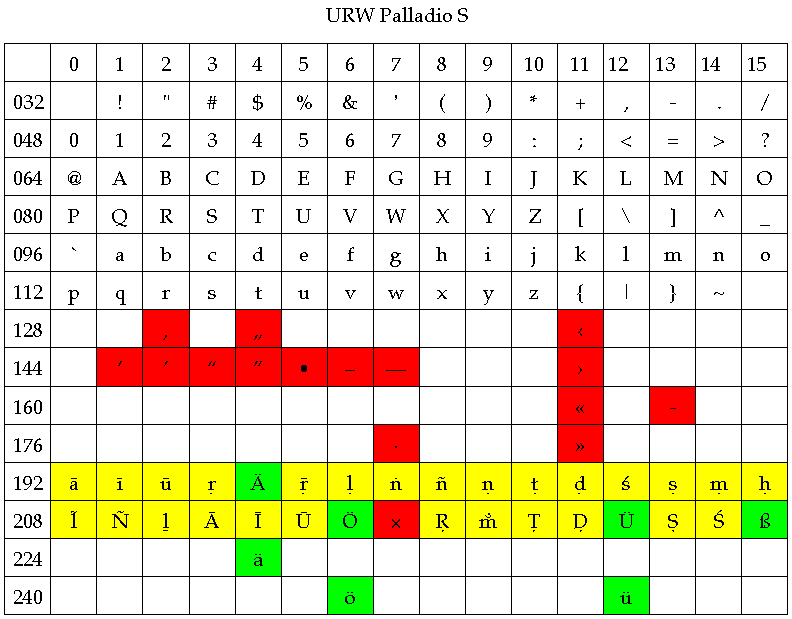
Yellow: Sanskrit
diacritics
Green: German diacritics
Red: Printer's specials
White: unused
Note: The font was enlarged by a few additional diacritics in the ANSI range 208-223 in February 2004. The encoding of the font "URW Palladio S" is used in a variety of searchable PDF files downloadable from this Sanskrit Web site and also from other sites. Therefore you should install this font (either PS or TTF), if you want to extract text passages from these searchable PDF files.
1. The PostScript
Type 1 font "URW Palladio S" is downloadable as PaSxps.zip.
2. The TrueType
font - with the same
font name - is downloadable as PaSx.zip.
Therefore you should install either the PS or the TTF font, but not both fonts.
How to extract the entire text from a "URW Palladio S" encoded PDF:
Example: Searchable PDF file of the text of the book "Aryabhatiya":
- For download visit
the site of Oriental
Institute University Lausanne
- Open aryabhat.pdf
into Acrobat reader and select continuous page
- Select All Text
(Ctrl-A) and Copy All Text (Ctrl-C) into clipboard
- Load any wordprocessor
and insert entire text by Insert All (Ctrl-V)
- Select All and
Markup All by Palladio S via font menue. That's it.
Diese Druckschrift ist für Lernende, aber auch für Profis bestens geeignet. Ich besitze zahllose Sanskrittexte in dieser meiner "Hauskodierung", die sich besonders gut für sehr kompakte Suchdateien und für das rasche Eingeben neuer Texte eignet.
"URW Palladio US" hat folgende Kodierung (vgl. dazu die obige PDF-Druckschrift "URW Palladio S"):
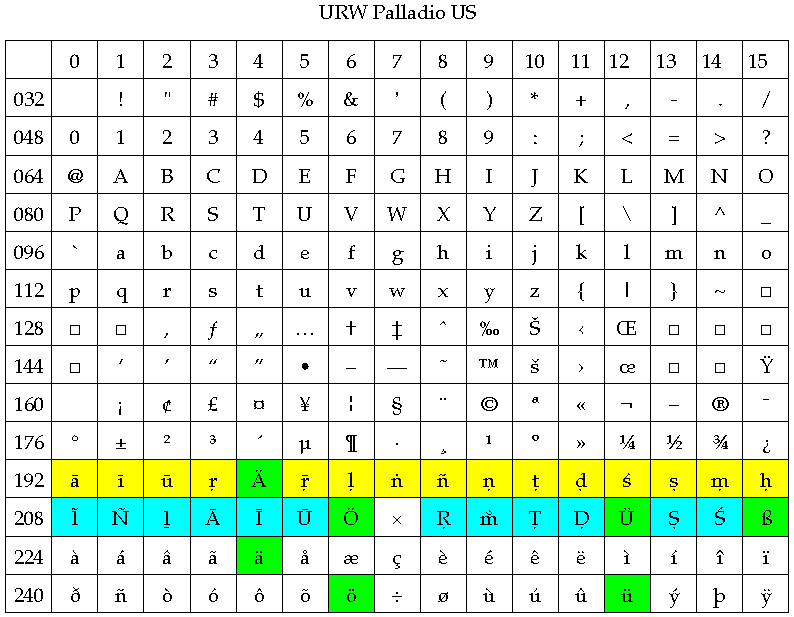
Für die gelben Zeichen werden Tastaturmakros für MS Word geliefert, so daß die Eingabe zum Kinderspiel wird:

Alles weitere entnehme man der bebilderten dreiseitige Anleitung, die als PaUSx.pdf heruntergeladen werden kann.
Das gesamte Paket bestehend aus der TrueType-Schrift "URW Palladio US", der PostScript-Schrift "URW-PalladioUS" (je in vier Schriftschnitten, beide gleichzeitig installierbar), der Tastaturmakro-Datei für MS Word (funktioniert unter älterem Word 97 genauso wie unter neuestem Word XP) und zwei Demo-Dateien für die TT/PS-Schriftarten ist als PaUSx.zip (270 KB) herunterladbar.
This font designed for Polish and German Indologists includes all diacritics for Classical and Vedic Sanskrit in both lowercase and uppercase. In addition, it includes all intonational accented vowels for Vedic Sanskrit in lowercase and additional vowel diacritics for Pali. Alternative diacritics used by some Indologists, linguists and grammarians as well as Tamil diacritics have been included too.
To be compatible with standardizations recommended by ISO 15919 ("Transliteration of Devanagari and related Indic scripts into Latin characters"), Palladio SKT also includes some rare diacritics defined by ISO 15919 (h underbar for Jihvamuliya, h underbreve for Upadhmaniya, long vocalic l) and underring-variants for r/l-liquids prescribed by ISO.
The keyboard layout of Palladio SKT is shown on the following chart:
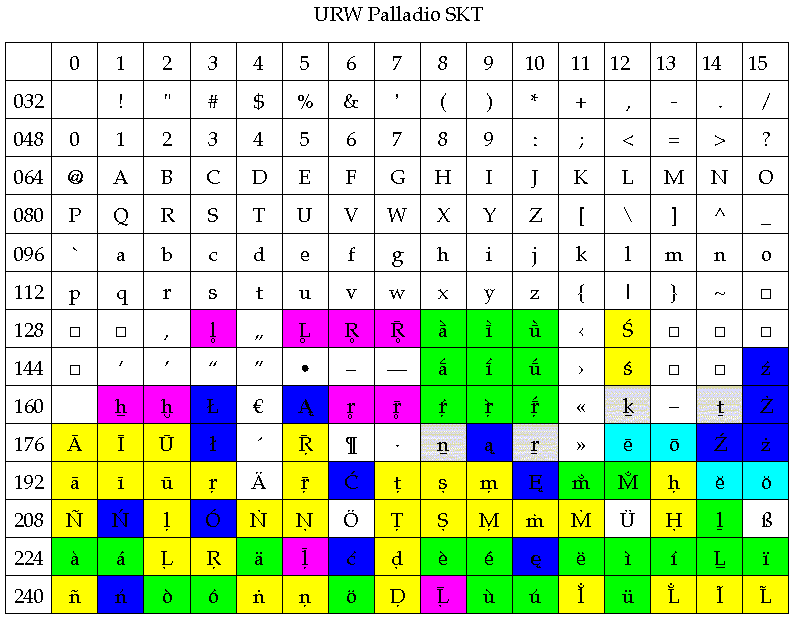
Yellow - Classical
Sanskrit: essential and extended diacritics (lowercase and uppercase)
Magenta - Classical
Sanskrit: additional Sanskrit diacritics as per ISO 15919 (lowercase)
Green - Vedic Sanskrit:
intonational accented vowels and diaeresis vowels (lowercase)
Cyan - Pali: additional
vowels for distinction between long and short e/o (lowercase)
Grey - Tamil: additional
diacritics with underbar (NB: l underbar both Vedic and Tamil)
White - German diacritics
and printer's specials (quotation marks, dashes, Euro etc.)
Blue - Polish diacritics
(for Indologists at the Catholic University of Lublin - KUL).
Palladio SKT comes in 4 styles - Roman, Italic, Bold and Bold Italic
A comprehensive description of all the diacritics of URW Palladio SKT is downloadable as 3-page PaSKT.pdf.
The TrueType font is downloadable as PaSKT.zip, the PostScript Type 1 font is downloadable as PaSKTps.zip.
This additional font has been designed for Polish and German orientalists, especially for Buddhologists, who need a choice selection of lowercase diacritics for other South-East Asian languages, not included in Palladio SKT. The specifications for this additional font have been made by the Catholic University Lublin (KUL). German and Polish diacritics have been arranged to be compatible with German and Polish keyboards. Palladio KUL comes in 4 styles - Roman, Italic, Bold and Bold Italic.
The TrueType font is downloadable as PaKUL.zip, the PostScript Type 1 font is downloadable as PaKULps.zip.
A detailed description of all pre-composed diacritics and of floating accents is downloadable as file PaKUL.pdf.
The keyboard layout of Palladio KUL, viewable in high quality as PaKULps.pdf, is shown on following chart:
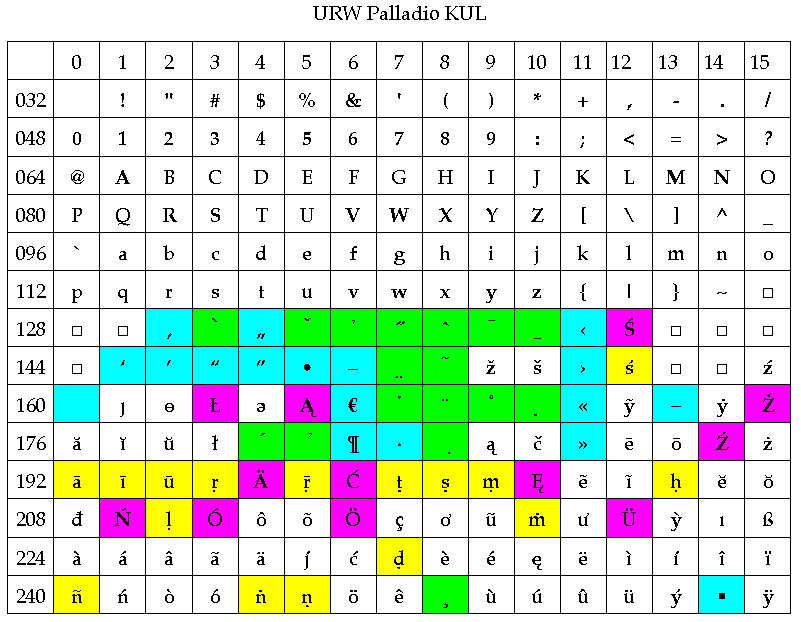
Cyan: Printer's specials
(quotation marks, round and square bullet, endash, soft hyphen, middot
etc.)
Magenta: Uppercase
German and Polish diacritics (The lowercase diacritics are marked up white)
Yellow: Lowercase
diacritics for Sanskrit with the same keyboard layout as used by Palladio
SKT
White: Lowercase
pre-composed diacritics for Buddhologists, including German-Polish diacritics
Green: Floating
accents adjusted for overstrike, tested under Corel WordPerfect 8.0 for
Windows
Note on Word Perfect: Under WordPerfect (NOT under Microsoft Word), URW Palladio KUL allows for building a great variety of additional lowercase diacritical characters with the overstrike command in combination with the following floating accents: grave (#131), caron (#133), Vietnamese hook or hoi (#134), Hungarian umlaut (#135), circumflex (#136), macron (#137), macron below or underbar (#138), dieresis below (#151), tilde (#152), dotaccent (#167), dieresis (#168), ring (#169), dotaccent below or underdot (170), acute (#180), off-center (positioned-to-the-right) Vietnamese hook or hoi (#181), off-center (positioned-to-the-right) underdot used in conjunction with y etc. (#184).
URW
Palladio M
(Mixed
Font for Catholic University Lublin)
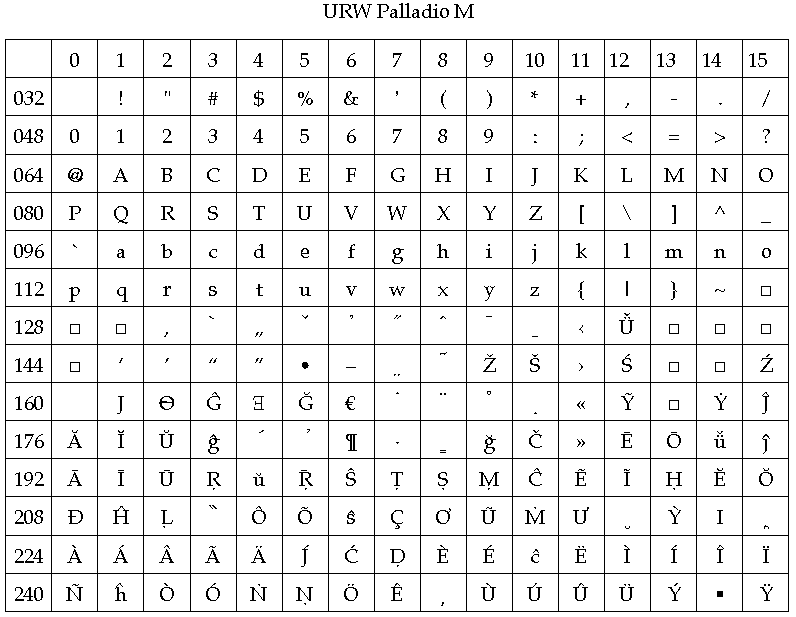
The mixed font URW Palladio M complementing above URW Palladio KUL, contains
a) all uppercase
diacritics complementing lowercase diacritics of Palladio KUL
b) all lowercase
and uppercase diacritics as required for the language Esperanto
c) several additional
floating accents for the Word Perfect overstrike command
The keyboard layout of Palladio M, viewable in high quality as PaMps.pdf, is shown on following chart:
URW Palladio M comes in 4 styles - Roman, Italic, Bold and Bold Italic.
The TrueType font is downloadable as PaM.zip, the PostScript Type 1 font is downloadable as PaMps.zip.
URW
Palladio Pali
(Font
for Buddhist Publication Society)
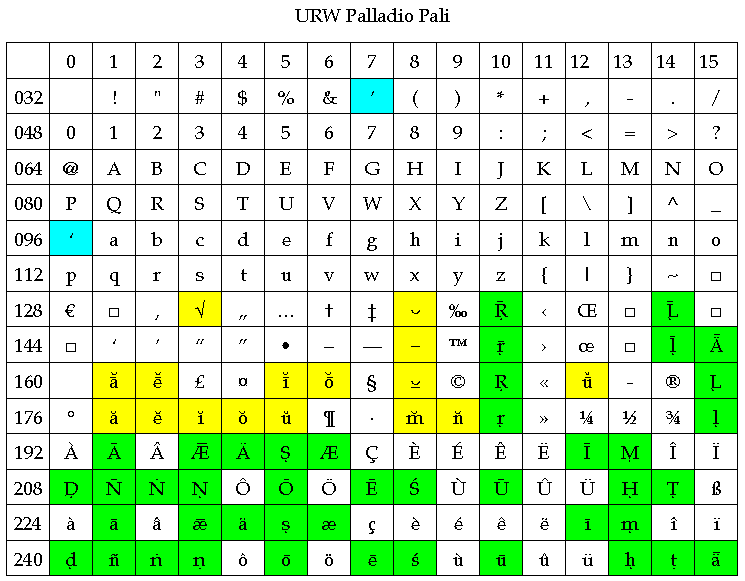
This Pali font was custom-made to the specifications of the Buddhist Publication Society (BPS) in Kandy (Sri Lanka). It covers Pali, Sanskrit and Sinhala diacritical characters, prosody signs and the diacritical characters needed for writing in French and German.
The detailed documentation is downloadable as PaPali.pdf.
The font package (4 styles each) downloadable as PaPali.zip contains 3 versions: TrueType (.ttf), PostScript Type 1 (.pfb) and OpenType (.ot). You may install all 3 versions at the same time. Use the version that looks best on your PC display screen.
Note: This Pali font happens to include all diacritical characters required for typesetting Latin textbooks and dictionaries.
Usual computer keyboards are designed for typing characters in the lower 7-bit ASCII range 32-127 only. But diacritics reside in the upper 8-bit ANSI range 128-255 or - in UNICODE fonts - in the 16-bit range 128-65535 (hex 0080-FFFF).
Note: The keyboard entry methods described below work also with older equipment (e.g. with old Windows 98 and old Word 97). Should you use Win XP and Word XP, you may also want to study special Win XP and Word XP keyboard entry methods described in my comprehensive technical manuals PaHOTman.pdf, pages 50-51, and ITmanual2003.pdf, pages 107-109.
a) Num Pad Method
On a Windows PC, diacritics in the range 128-255 may be entered by pressing the ALT key and - while still keeping the ALT key pressed - by typing the decimal code of the diacritic character on the number keypad which is to the right of the keyboard. Do NOT use the number keys in the top row. The decimal code must be prefixed by a zero, i.e. 0128 instead of 128 etc. For instance, the decimal code for "Ä" is 196 (see above chart of URW Palladio SKT). Therefore you press ALT and type 0196 on the num pad. This num pad method does NOT work for UNICODE characters in the range 0100-FFFF.
The num pad method of entering diacritics is very clumsy. Therefore the following two methods are recommended.
b) Keyboard Shortcuts
For diacritics most often used, e.g. for the 15 lowercase diacritics of classical Sanskrit, it is recommended to define keyboard shortcuts or macros, e.g. "Alt Ctrl N" for "n tilde", "Alt N" for "n overdot", "Ctrl N" for "n underdot", etc.
The following screen shot shows the menu for defining keyboard macros in MS Word 1997 on a German computer:
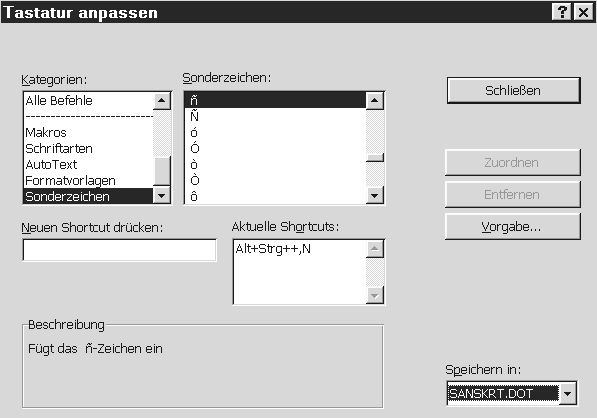
c) AutoCorrect Mnemonics
In Word 97, you may define both ANSI and UNICODE diacritics by the AutoCorrect method as follows:
1. Open the Symbol
Map ("Sonderzeichen") and mouse click on the desired ANSI or UNICODE character.
2. Select "Autocorrect"
("Autokorrektur") and enter a desired mnemonic for the diacritic with delimiters.
Mnemonics must begin and end with a "delimiter", i.e. with any non-alphanumerical sign such as #, /, \, etc.
Example: For r underring with macron and acute you could use one of the following delimited mnemonics:
#r-'# or /r-'/ or \r-#\ or #rma# or /rma/ or \rma\ etc. etc. Choose whatever can be typed most easily.
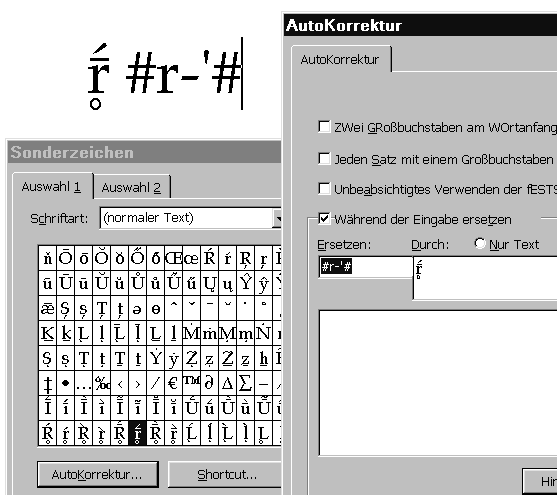
A detailed description of the AutoCorrect method is given in the MS Word document Eureka.doc by Dermod Quirke and Brian Holser, who have given permission to Ulrich Stiehl to publish their interesting "Eureka" article on this fonts site.
If the methods described above are not efficient enough, you might consider buying a specialized computer keyboard including dozens of ADDITIONAL keys freely definable by the software supplied with these specialized keyboards.
The most comprehensive collection of links to transliteration and Devanagari fonts is found at Indic Language Fonts, regularly updated by Luc Devroye, who hosts the greatest font-related website on the internet. Links to font sites are also found at the Sanskrit Documents Site, the greatest site for Sanskrit texts in Devanagari and ITX encoding on the internet.
a) ITX-Converters:
Itranslator 99 and Itranslator 2003 by Swami Satchidananda
Itranslator, developed by Swami Satchidananda, converts ITX encoded files to Transliteration and Devanagari and is best suited for the conversion of ancient Classical and Vedic Sanskrit texts. With some technical restrictions, Itranslator can also be used for the conversion of modern Hindi/Marathi/Nepali texts. For Itranslator fonts see here.
ITRANS, developed by Avinash Chopde, also converts ITX encoded files to Transliteration and Devanagari, but is best suited for mixed Devanagari texts, e.g. Hindi plus Sanskrit. The current release Itrans 5.30 is available since July, 2001. While Itranslator can be used even by computer novices, Itrans requires more advanced computer skills.
b) CSX-Transliteration Fonts:
The old CSX fonts
are downloadable from the above websites and also from the website of Gudrun
Buehnemann.
The new CSX+ fonts are available from this website. Note:
CSX fonts are adapted only to English (British-American) keyboards.
c) Transliteration Fonts for Pali and Sanskrit:
PS and TT Fonts for Pali by Phil Thompson
The Pali fonts by the late Chandra Yenco (his geocities subsite was closed in 2005) used a modified subset of CSX encoding. The Pali fonts by Phil Thompson, based on the fonts by Chandra Yenco, are available as TrueType and PostScript Type 1 Windows fonts and also as Macintosh fonts. Since 2004, these Pali fonts are also available as Unicode fonts.
TrueType Fonts for Pali by Bhikkhu Pesala
The Pali fonts by Bhikkhu Pesala (Unicode fonts with additional diacritics for all European languages) are useful for German Indologists, since German diacritics are accessible by the German keyboard.
d) TrueType Font Package for all Indic Languages for MS Word:
INDOLIPI by Elmar Kniprath (Assamese, Bengali, Gujarati, Tamil, etc. etc. - Kniprath's former website is defunct)
The Font Package by Elmar Kniprath comprising numerous TrueType fonts and Microsoft Word keyboard templates covers the languages Assamese, Bengali, Grantha, Gujarati, Hindi, Kannada, Malayalam, Marathi, Nepali, Panjabi, Rajasthani, Sanskrit, Sinhalese, Tamil, Telugu, and in addition Latin transliteration and Phonetic transcription.
- The versions 1.0 and 2.0 of these fonts were completely incompatible with Unicode, since they did not use the Private Use Area, but redefined the Cyrillic, Greek etc. ranges of Unicode for Devanagari etc. and for the transliteration characters (no longer available).
- The versions 3.0 (October 2004) of these fonts were partly Unicode-compatible. For using these fonts you need a large (5 MB !) DOT Macro file. For details see the 15-page manual supplied with the font package (no longer available).
- The current version (2010) now called "INDOLIPI Software for Indologists and Linguists" is based on OpenType Unicode-compatible TrueType fonts. It also includes various converters and a new font for the Tamil-Grantha script.
Sanskritweb is maintained by Ulrich Stiehl, Heidelberg (Germany)